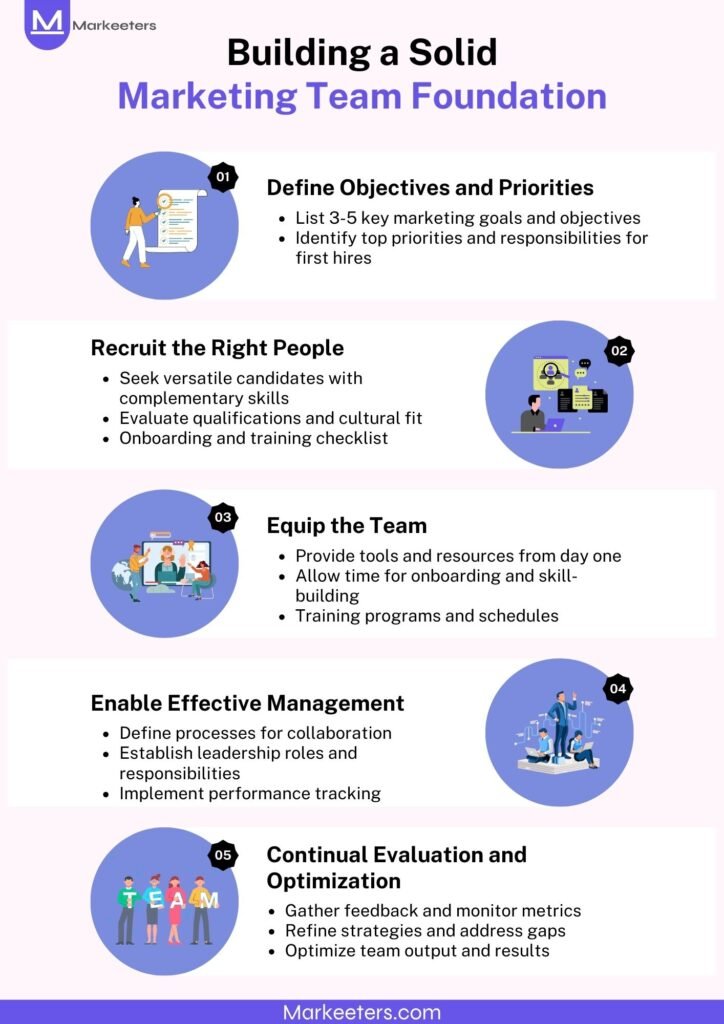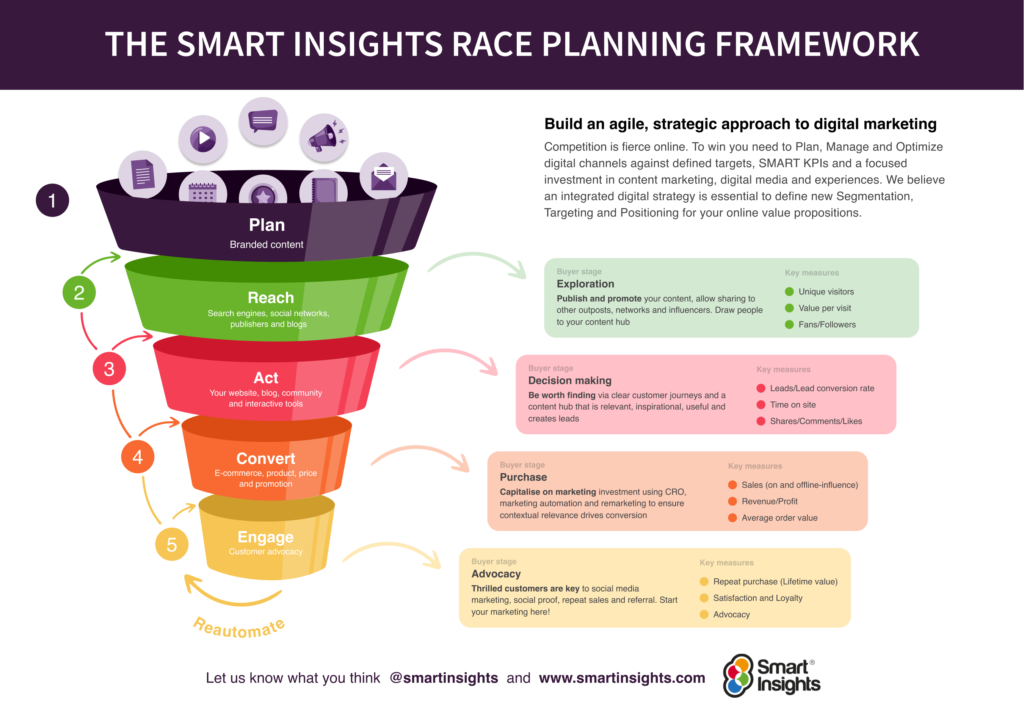As an entrepreneur or business leader, creating a successful in-house marketing team from the ground up can be a daunting task. You may be unsure where to start, which positions are critical, and how to guarantee your team’s triumph. This guide offers a step-by-step approach to building a strong marketing team from scratch.
The first order of business is laying a solid foundation. Take time to thoughtfully define your marketing objectives and priorities. Also, outline core responsibilities and expectations for initial team members.
Once the foundation is in place, you can begin the important work of recruiting. Look for versatile candidates who bring complementary skillsets to the table. Consider applicants’ qualifications as well as cultural fits.
Equipping your new hires is another critical phase. Ensure everyone has the tools, resources, and training they need from day one. Make time for onboarding and skill-building.
Effective communication and management will help maximize productivity over the long haul. Define processes for collaboration, leadership, and performance tracking. Recognize individual strengths and contributions.
Constant evaluation allows for continual optimization. Gather feedback and monitor metrics to refine strategies, spot gaps, and keep the team primed for progress.

Building a cohesive in-house marketing crew takes intentional effort from all involved. But by following this guidance, you’ll get complete clarity on How to build a strong marketing team from scratch, and you’ll be well on your way to assembling a driven team of professionals ready to take your business to new heights.
Laying the Groundwork: Structures, Roles and Responsibilities
Before hastily assembling your marketing team like rushed IKEA furniture, establish a solid foundation. Just as concrete stabilizes a house, this groundwork will support your entire team structure.
The initial critical pillars are determining your:
- Organizational structure
- Team roles
- Responsibilities framework
Sounds scintillating, I know. But do this right from the outset and you avoid major rework down the road. Let’s break it down.
Challenge 1: Identifying the Optimal Team Structure
One of the first tasks when building your organization is determining the ideal structure for your marketing team. There are three primary options to consider:
Centralized Structure
A single centralized department oversees all marketing efforts. This ensures cohesive branding and messaging. However, it can hamper local autonomy and agility.
Decentralized Structure
Marketing resources are distributed across business units and locations. This empowers regional teams and speeds hyper-local initiatives. But it risks inconsistent branding without tight guidance.
Hybrid Model
A balanced approach combining centralized governance with empowered regional operations. For example, brand standards come from headquarters while local offices tackle community-driven programs.

When evaluating these structures, analyze your:
- Strategic priorities like growth plans, talent needs
- Operational diversity based on products, services, location
- The regulatory environment in your industry
- The desire for efficiency versus response speed
Gather input from cross-functional partners to understand pains and opportunities from all angles. Weigh pros and cons using qualitative and quantitative models.
By taking a thorough, consultative approach you’ll identify the optimal starting framework. Both your situation today and future ambitions will influence this pivotal choice.
Challenge 2: Defining Marketing Team Roles
With your organizational framework now firmly set, the next pivotal step is crafting specialized roles to power your strategy.
All too often I see generic “marketing associate” postings that fail to prepare candidates or help hiring managers envision actual day-to-day work. This leads to overlap, inefficiency, and suboptimal performance over time.
Rather than taking such an ad hoc approach, carefully map each unique function needed. Some key positions may include:
- Content Marketing Manager: Responsible for creating engaging blog posts, videos, and long-form articles. Manages content calendar and optimizes for SEO. Reports on performance metrics to improve strategy.
- Social Media Manager: Oversees all social media profiles and paid campaigns. Posts daily across channels and analyzes insights to refine messaging and growth. Leads social listening and engagement efforts.
- Email Marketing Specialist: Designs and tests email campaigns. Improves list and segmentation. Tracks metrics like open and click rates to optimize mailouts. Responsible for nurturing leads and growing the subscriber database.
- SEO Analyst: Researches keywords and site structure to boost organic traffic. Implements technical optimizations and tracks rankings. Partners with the content team on SEO-enhanced articles and internal linking. Reports on monthly search volume and position changes.
- Paid Search Manager: Defines target audiences and geo/demo targeting. Builds campaigns and ad groups across search and social platforms. Responsible for budget management and optimizing campaigns for ROAS goals.
- Graphic Designer: Creates designs, templates, and branding assets for all marketing collateral from social posts to sales sheets. Ensures visual identity remains cohesive across touchpoints.
- Web Developer: Develops and maintains optimized marketing websites and landing pages using standard coding practices. Troubleshoots bugs and implements improvements iteratively based on usability testing and analytics.
- PR Specialist: Pitches stories and helpful data to secure features, interviews, and third-party endorsements. Monitors placements and expands influencer network. Measures impact on goals like new visitor traffic.
- Events Coordinator: Plans and executes conferences, webinars, and other experiences. Manages logistics, registration, sponsorships, and onsite support to maximize attendee engagement and sales leads.
Additionally, determine which roles are mission-critical from launch versus nice-to-have down the road as your needs evolve.
For each, Define in-depth:
- Responsibilities like output goals, processes, and ownership
- Skill sets and experience required
- KPIs to measure their individual impact
- Opportunities for career progression
- Compensation ranges commensurate with the market
By front-loading role clarity, we give recruiters clear guidance and future team members transparency into expectations and opportunities.
With specialized cogs in place, your well-oiled marketing machine will hit the ground running.
Building a Skilled, Diverse Marketing Team
With well-defined roles, structures, and processes in place, the next crucial step is gathering a dynamic team of professionals. Attracting and retaining top talent is paramount to bringing the strategy to life. A couple of keys to keep in mind are rigorous vetting processes and prioritizing diversity from the start.
Challenge 3: Recruiting Top Marketing Talent
Let’s address the elephant in the room – hiring good marketers is HARD.
With so many charlatan “gurus” and fluffy resumes out there, it’s tough to assess abilities. Plus, competition for talent is fierce.
Here are proven strategies to attract rockstar players:
• Clearly defining “must-have” qualifications up front streamlines candidate evaluation. Beyond just hard skills, consider how applicants’ soft skills like collaboration and problem-solving align.
• Craft compelling job postings that sell the exciting upside of your brand culture and potential for growth. Share your mission passionately to attract innovators.
• Cast a wide aperture through diverse sources – not just core boards but innovative pipelines like referral programs, campus outreach, and community partnerships. This nets the most versatile prospect pools.
• Video interviews offer a deeper look beyond just resumes into how candidates think and present. Assess cultural complementarity, not just competence.
• Skill tests and case study assignments can further illuminate applicants’ strengths beyond hearsay. Make the audition process collaborative to identify team players.
• Trust your intuition – it’s OK if quality concerns emerge, so probe politely for transparency. The priority is onboarding motivated self-starters.
• The best candidates won’t last long. Be ready to interview and make offers promptly before they’re snatched up. Speed matters given competition – but move thoughtfully.
With the right recruits in place, the focus shifts to fostering an inclusive environment where diverse talents thrive.

Challenge 4: Fostering Diversity and Inclusion
Diversity amplifies a team’s skill sets, perspectives, and creativity.
Research shows diverse teams make better decisions 87% of the time and bring in 60% better results. It’s time to fully leverage inclusion!
| Objective | Description |
|---|---|
| Build Bias Awareness | Require unconscious bias training for hiring leaders to identify subtle prejudices influencing decisions. |
| Cast a Wider Recruitment Net | Advertise roles in diverse communities and media to attract top talent from all backgrounds. |
| Judge Candidates impartially | Use structured evaluations and standardized interviews initially to remove personal biases from screening. |
| Focus on Qualifications, Not Attributes | Remove identifying details from applications at first to spotlight skills over anything else. |
| Cultivate a Sense of Belonging | Foster open communication and zero tolerance for discrimination so every voice feels valued. |
| Pay it Forward as Mentors | Sponsor networks and mentorship to retain diverse talent through support and sponsorship. |
Continuous learning is key, yet inclusion’s rewards vastly outweigh efforts. By blending views, we solve problems beyond any single perspective’s limitations. Now that the team reflects on your customers, how can technology empower their success? On to discussing enabling tools!
Equipping Your Team to Excel
You constructed a solid foundation. You built sturdy walls with skilled talent. Now it’s time for the electrical – marketing tools and technologies to empower your team.
The two key challenges are:
- Selecting platforms to support marketing efforts
- Developing team skills continually
Let’s shed some light on how to address them.
Challenge 5: Choosing the Right Marketing Technologies
Today’s marketing landscape runs on technology. The toolbox available is staggering – over 11,000 martech solutions across categories like:
- Advertising and promotion
- Content marketing
- Social media marketing
- Email marketing
- Sales enablement
- Analytics and Reporting
- CRM and marketing automation
- and much more…
With so many options, focusing on tools that align with your strategy and team skills is vital:
| Suggestion | Description |
|---|---|
| Audit Existing Tech Stack | Inventory all current software platforms and tools used by marketing and the broader organization. Identify gaps. |
| Involve the Team | Get input from team members on desired functionalities to empower their roles. They’ll provide user perspectives. |
| Assess Ease of Use | Ensure tools are intuitive and easy to adopt. Complex platforms with steep learning curves fall into disuse. |
| Evaluate Integrations | Select tools that seamlessly integrate with each other via APIs and connectors to enable data flows. |
| Calculate Total Cost of Ownership | Factor in all direct and indirect costs like licensing, maintenance, training, and internal support. |
| Read Independent Reviews | Consult unbiased reviews on functionality, pricing, and customer support to guide buying decisions. |
Choosing the RIGHT marketing technology – not necessarily the most HYPED – can profoundly empower your team. But great tools only fulfill potential with skilled hands using them.
Challenge 6: Developing Team Skills and Knowledge
Continuous learning is mission-critical in this dynamic industry. Develop skills through:
| Suggestion | Description |
|---|---|
| Personalized Growth Plans | Partner with team members to create goals and a tailored development roadmap leveraging strengths. |
| Hands-on Industry Experience | Sponsor attendance at conferences, seminars, and networking events relevant to their specialization. |
| Internal Knowledge Exchange | Host regular “Lunch & Learn” sessions where team members share new learnings and developments. |
| Self-Directed Education | Provide subscriptions to online platforms for on-demand training to expand competencies at their pace. |
| Valuable Certification | Cover costs for certifications elevating skills and career opportunities based on roles. |
| Foster Experimentation | Celebrate continuous growth through a culture encouraging new tech trials and development, without micromanaging the learning process. |
With an evolving skillset, how can workflows maximize the team’s new powers? On to optimizing operations through structured processes…
Driving Productivity and Alignment
You built a solid foundation. You constructed the walls with a talented, diverse team. You powered up the house through tools and training.
Now it’s time to add deliberate workflows and rituals to channel team energy toward mission success.
Challenge 7: Enabling Flawless Collaboration
With team members often distributed, clear communication is vital. Ensure information flows through:
| Suggestion | Description |
|---|---|
| Establish Regular Standups | Institute short, focused recurring meetings for status updates, coordination, and roadblock removal. |
| Institutionalize Knowledge | Use centralized drives, wikis, and project management for access to assets, plans, and institutional understanding. |
| Circulate Performance Insights | Regularly share analytics, campaign results, and key metrics to maintain alignment. |
| Send Weekly Progress Reports | Email recaps of significant milestones, new initiatives, and upcoming projects. |
| Welcome New Perspectives | Actively solicit ideas and feedback through both formal and anonymous channels. |
| Foster Relationship Building | Don’t limit off-topic discussion – real connections enhance collaboration long term. |
With open communication channels established, next focus your team on achieving strategic marketing objectives.
Challenge 8: Setting Effective Goals and Metrics
You’ve assembled dream team 2.0, equipped them for greatness, and optimized collaboration. Now ensure efforts support business objectives through defined goals.
| Suggestion | Description |
|---|---|
| Strategically Align KPIs | Connect marketing targets to broader company goals like revenue, and market share for a shared vision. |
| Make Goals Specific, Measurable & Timebound | Use SMART frameworks to enhance clarity, and focus energy in high-value directions. |
| Assign Point People | Ensure accountability by designating owners for each goal and metric responsible for progress reports. |
| Track Leading and Lagging Indicators | Identify metrics that lead to outcomes as well as results to enable proactive adjustments. |
| Automate Where Possible | Utilize systems to effortlessly pull performance insights vs. manual, error-prone reporting. |
| Continuously Optimize | Revisit metrics at least quarterly, dynamically reallocating resources as situations evolve. |

With seamless communication workflow and aligned goals, your marketing flywheel starts spinning. But continual optimization keeps up the momentum.
Monitoring and Improving Team Performance
You constructed your marketing team’s solid foundation. You built the walls and powered them up. You installed workflow systems.
But the work doesn’t stop there. To maximize results you need to continually monitor team execution and embrace opportunities to improve.
This boils down to two imperatives:
- Tracking marketing performance
- Adapting to market changes
Let’s break down how to achieve these.
Challenge 9: Measuring Marketing Success
Strict KPI monitoring ensures your initiatives drive ROI. Key metrics to track include:
Traffic and Engagement
Monitor site visits, pages per visit, time on site, email open rates, social actions, etc. Signals audience interest.
Leads and Conversions
Analyze new prospects captured, email subscribers, trialed products, etc. Shows sales pipeline growth.
Revenue and Profit
Ultimately marketing drives incremental sales, profit, and customer lifetime value. Tie activities to these outcomes.
Return on Investment (ROI)
Measure marketing’s impact on profitability. Demonstrates contribution and guides budgets.
Campaign Results
Assess individual initiative performance – clicks, cost per conversion, sales influenced, etc. Identify what resonates.
Competitive Benchmarking
Compare your KPIs vs. competitors and industry standards to identify gaps.
Customer Satisfaction
Survey the target audience regularly to assess brand perception, satisfaction, and needs.
Consistent performance tracking ensures you take the pulse of initiatives and quickly course-correct them. But you also need peripheral vision to spot emerging trends.
Also Read: How to Prioritize Marketing Channels Based on ROI
Challenge 10: Adapting Team Initiatives to Market Shifts
To sustain success, your marketing team must remain agile and aware of changes like:
Consumer Trends
Shift strategies based on the latest behaviours, values, and preferences of your target audience.
New Technologies
Evaluate and adopt breakthrough platforms, tools, and innovations that could advance initiatives.
Competitor Activities
If rivals launch new campaigns or tactics, assess whether your team should follow suit.
Channel Disruption
Adapt plans to capitalize on the rise of emerging channels like TikTok while legacy channels decline.
Industry Changes
Evolve strategies to align with new regulations, M&A moves, supply shocks, etc. that impact your market.
Macroeconomic Forces
Account for recession impacts on consumer spending, regional differences, inflation, etc. in planning.
This hyper-awareness of market dynamics allows you to continually refine team priorities and activities for maximum impact.
But even the most talented marketing team burns out without sustained motivation and satisfaction. Let’s cover that next.
Sustaining Team Passion and Engagement
After building your marketing team’s solid base, attractive structure, seamless workflows, and performance tracking, the final touch is nurturing engagement.
Happy, aligned teams thrive. Follow these strategies to maintain energy and motivation:
Challenge 11: Increasing Employee Satisfaction
Beyond competitive compensation, retention hinges on fulfilment and growth. Cultivate this by:
Offer Autonomy and Flexibility
Provide schedule flexibility, remote work options, and trust. Micromanaging stifles motivation.
Create Learning and Growth Opportunities
Support training, new challenges, and career development. Expand skill sets.
Give Recognition
Celebrate wins, highlight achievements, and send kudos frequently. Appreciation fuels retention.
Promote Work/Life Balance
Don’t demand excessive overtime. Encourage vacations and taking breaks. Burnout is real.
Provide Strong Leadership
Good leadership establishes clear direction while supporting team needs. Employees don’t leave jobs, they leave managers.
Measure Satisfaction Regularly
Gather feedback on happiness, culture, development opportunities, etc. Fix issues quickly that arise.
With individual satisfaction nurtured, aligning your team into a collaborative unit generates even more energy.
Challenge 12: Bringing the Team Together
A strong culture cements team cohesion. Foster this through:
Define Shared Values and Purpose
Establish guiding principles for decision-making, conduct, and community impact.
Facilitate Team Bonding
Host fun remote or in-person social events, offsites, and activities. Invest in relationships.
Show Individual Appreciation
Personalize kudos, rewards, and recognitions for contributions and successes.
Embrace Humility and Transparency
Admit mistakes. Be vulnerable and real instead of projecting “perfection.”
Open Cross-Department Collaboration
Encourage working across silos. Align teams to shared goals.
Give Back Externally
Organize volunteer events supporting charity partners. Strengthens camaraderie through common cause.
Collect Feedback
Use anonymous pulse surveys to monitor team sentiment and catch issues early.
By making your people feel valued individually and collectively, the team unit gels into a true powerhouse primed to overcome any challenge.
Let’s Build Your Winning Team!
There you have it – a comprehensive, step-by-step guide to building a stellar marketing team tailored to your business needs while avoiding common pitfalls.
Here’s a quick recap of the key steps we covered:
- Establish your team structure and roles
- Recruit skilled, diverse team members
- Equip them with tools and training
- Instill productive workflows
- Continually monitor performance
- Sustain motivation and engagement
Now you’re ready to start constructing your marketing dream team from the ground up!
Of course, building an effective team is an evolving endeavour requiring ongoing care and commitment. But enact these strategies, and you will undoubtedly propel your marketing and business success to new heights.
If you need an experienced guide on your team-building journey, don’t hesitate to reach out. We’re always happy to help take your marketing ambitions from vision to reality.
Here’s to your future all-star marketing squad! Let’s start turning your team goals into reality.
FAQs on How To Build A Strong Marketing Team From Scratch
What does a high-performing marketing team look like?
A high-performing team is made up of specialists in key areas like content, paid media, design, and PR who work seamlessly together towards shared objectives. Strong collaboration, metrics-driven decision-making, and continuous skill development are also signs of a top team.
What does every marketing team need?
At a minimum, a basic yet balanced marketing team needs roles focused on content creation, distribution, and relationship building. Specifically – a social media manager, designer, writer, and customer success rep. Additional specialized roles can then be added as the budget allows.
How big should a marketing team be?
There’s no one-size-fits-all answer but generally a startup may only require 2-3 people while mid-market companies could support a team of 5-7. Larger enterprises may have departments of 10+ separated into sub-teams. It depends greatly on a brand’s revenue, industry, and annual growth projections.
What are the five keys to a strong marketing strategy?
The five pillars include – clear target personas, data-driven campaigns, cohesive branding, optimized websites, and consistent lead nurturing programs.
What is the main goal of a marketing team?
The overarching objective of any marketing team is to drive qualified leads and increase revenue in a cost-effective manner through both online and offline activities. They help strengthen a brand and move potential customers through the purchasing funnel.





